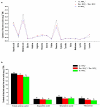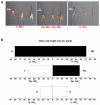Characteristics of Free Amino Acids (the Quality Chemical Components of Tea) under Spatial Heterogeneity of Different Nitrogen Forms in Tea (Camellia sinensis) Plants
- PMID: 30678321
- PMCID: PMC6385162
- DOI: 10.3390/molecules24030415
Characteristics of Free Amino Acids (the Quality Chemical Components of Tea) under Spatial Heterogeneity of Different Nitrogen Forms in Tea (Camellia sinensis) Plants
Abstract
Nitrogen (N) forms are closely related to tea quality, however, little is known about the characteristics of quality chemical components in tea under the spatial heterogeneity of different N forms. In this study, a split-root system, high performance liquid chromatography (HPLC), and root analysis system (WinRHIZO) were used to investigate free amino acids (FAAs) and root length of tea plants under the spatial heterogeneity of different N forms. Uniform. (U.) ammonium (NH₄⁺) (both compartments had NH₄⁺), U. nitrate (NO₃-) (both compartments had NO₃-), Split. (Sp.) NH₄⁺ (one of the compartments had NH₄⁺), and Sp. NO₃- (the other compartment had NO₃-) were performed. The ranking of total FAAs in leaves were as follows: U. NH₄⁺ > Sp. NH₄⁺/Sp. NO₃- > U. NO₃-. The FAA characteristics of Sp. NH₄⁺/Sp. NO₃- were more similar to those of U. NO₃-. The contents of the important FAAs (aspartic acid, glutamic acid, and theanine) that determine the quality of tea, increased significantly in U. NH₄⁺. The total root length in U. NH₄⁺ was higher than that in the other treatments. More serious root browning was found in U. NO₃-. In conclusion, NH₄⁺ improved the accumulations of FAAs in tea leaves, which might be attributed to the root development.
Keywords: free amino acids; heterogeneity; nitrogen forms; root development; tea quality.
Conflict of interest statement
The authors declare no conflict of interest.
Figures



References
-
- Romero C.M., Engel R.E., Chen C.C., Wallander R. Microbial immobilization of nitrogen-15 labelled ammonium and nitrate in an agricultural soil. Soil Sci. Soc. Am. J. 2015;79:595–602. doi: 10.2136/sssaj2014.08.0332. - DOI
MeSH terms
Substances
Grants and funding
- 41601329/National Natural Science Foundation of China
- 41877006/National Natural Science Foundation of China
- 31570695/National Natural Science Foundation of China
- Y20160011/the Open Foundation of State Key Laboratory of Soil and Sustainable Agriculture
- 2016C02053-8/the Major Science and Technology Special Project of Variety Breeding of Zhejiang Province
LinkOut - more resources
Full Text Sources
Miscellaneous

